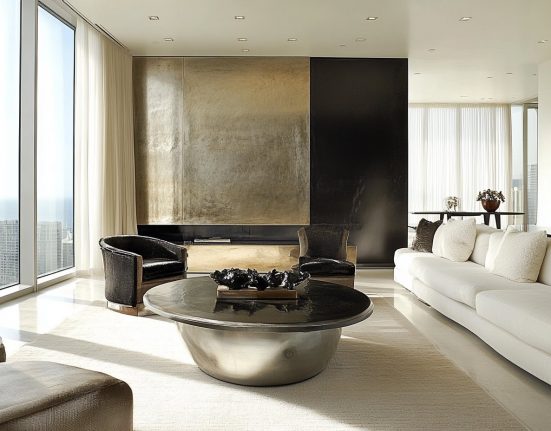Designer Candice Stanley bought the Christchurch house she grew up in from her mum and dad eight years ago, and last year completed a major renovation.
The house she shares with husband Tom and daughters Ivy (16 months) and Adelaide (seven weeks) is unrecognisable from how it was, and a lot of that is down to the way Stanley has styled the living room.
“When Mum visits she says, ‘why did we never think to position the furniture like this?’ That’s because most of us don’t think the couch and chairs can be moved around.”
Rethinking the way your living room is arranged can make a big difference to how it looks and works, and the designer’s own home is proof. But Stanley (nee Van Dyk), who runs Mooi Design, says it helps to have a starting point for any plan, and it’s not helpful to upload a stack of Pinterest photos of rooms you like.
“If you love everything, you can end up with a real mish-mash of styles, so I say put the Pinterest stuff aside. Focus instead on how the room is used, and maybe one special thing you have, like a painting.
“One of my clients had a large graffiti-style artwork, and we used that as the starting point, picking up colours and textures from the painting for the furnishings. Another client had an antique sideboard with worn edges. That drove the direction for the design.”
Stanley is not really a fan of long corner sofas for entertaining. “A corner couch may be big enough to seat six, but you will never have that many people sitting in a row and around the corner. It’s not conducive to conversation. I think it’s much better to mix your seating with a three-seater sofa and a couple of armchairs, or maybe two sofas and one chair.
“The advantage of having armchairs or occasional chairs is that you can put them in front of a door that opens to the outdoors without blocking the view or the exit. And you can do something interesting with the fabric on chairs, maybe using a lovely velvet or a pattern. It’s also cheaper to reupholster a single chair than a couch.
“Armchairs can be more rounded, with lower arms. They don’t feel too bulky in a room – if the base is slightly elevated above the floor, the look is not so heavy, and there’s a better flow through the space.”
Stanley says pulling the furniture away from the wall is key. “Don’t be afraid to do this. It doesn’t make the space feel smaller, rather the opposite. And it’s much more suitable for entertaining and conversation. It can free up space for a console behind, with a lamp.”
There’s a plea from almost every designer to not make the TV the focal point in a living room. “Think instead of making a fireplace or a favourite piece of art the focal point,” Stanley says.
“Put the TV on a low entertainment unit off to one side. It’s a much better viewing position than high up on a wall. If there’s enough in the budget, I like to have a built-in unit off to one side for the TV and storage.”
Natina Hellowell, of The Design Depot in Hamilton, says most of her clients opt for simple, neutral colours for their sofas. “We do a lot of neutrals, layering of textures, wools, chunky weaves, bouclé and different fabrics, bringing in colour with cushions. In general, the look is a lot more relaxed than even just a few years ago when we used to line up all the cushions and give them a karate chop in the middle.
“Today, the look is not nearly so structured or staged. And there’s a bigger emphasis on good-quality products, like sofas with feather inners, and sure you might make a dent when you sit. But that’s what we love. If you have people over, you want them to relax.”
Hellowell says this also applies to the way we decorate: “We’ve gone from fake plants and everything staged ‘just so’, with three vases grouped on the coffee table. Now we have earthy pots with sticks or bracken out of the garden – things you collect along the way. It’s still a funky, modern look, but more natural.”
The designers also have good ideas on coffee and side tables. Stanley is a fan of large round ottomans, which are multifunctional. They might have a slide-away coffee table over the top, or a tray. But they also work as a footstool, and they are much softer for young children, who might be playing in the room.
Hellowell likes round coffee tables grouped in different sizes – “it breaks things up, visually. They look good together, but they can be separated to create side tables beside sofas.”
Rugs are also invaluable decorating aids. “Rugs can define a zone within an open-plan living space,” Stanley says. “And when choosing rugs, make sure they are big enough to have the front legs of your couch and chairs on the rug. This makes sure everything is connected, visually.”
The designer says she is a big fan of outdoor rugs, and also outdoor fabrics on sofas because they are much easier to clean. “You can’t tell the difference to look at them, but they are invaluable if you have children.”
Hellowell says rugs are another way to bring “depth and texture” into the room – a key part of the layering that transforms a room. She also likes to “go large”. “Back in the day it was 1.6m x 2.30m, and it sat in the middle of the room. Now we like the rug to sit under all the furniture.”
Curtains, also, will add the finishing touch – or shutters and blinds. “Drapes can really warm up a room and change the whole look,” the designer says. “Window treatments are just as important as the flooring.”
Polyester fabrics will be more durable than natural fabrics for a room that gets direct sunlight – you can replicate the look of linen with the assurance of longevity.
Last, but never least, be sure to incorporate mood lighting into your room. If you have downlights, make sure they are on a dimmer. But using floor and table lamps instead at night makes for a more relaxing, intimate room.







